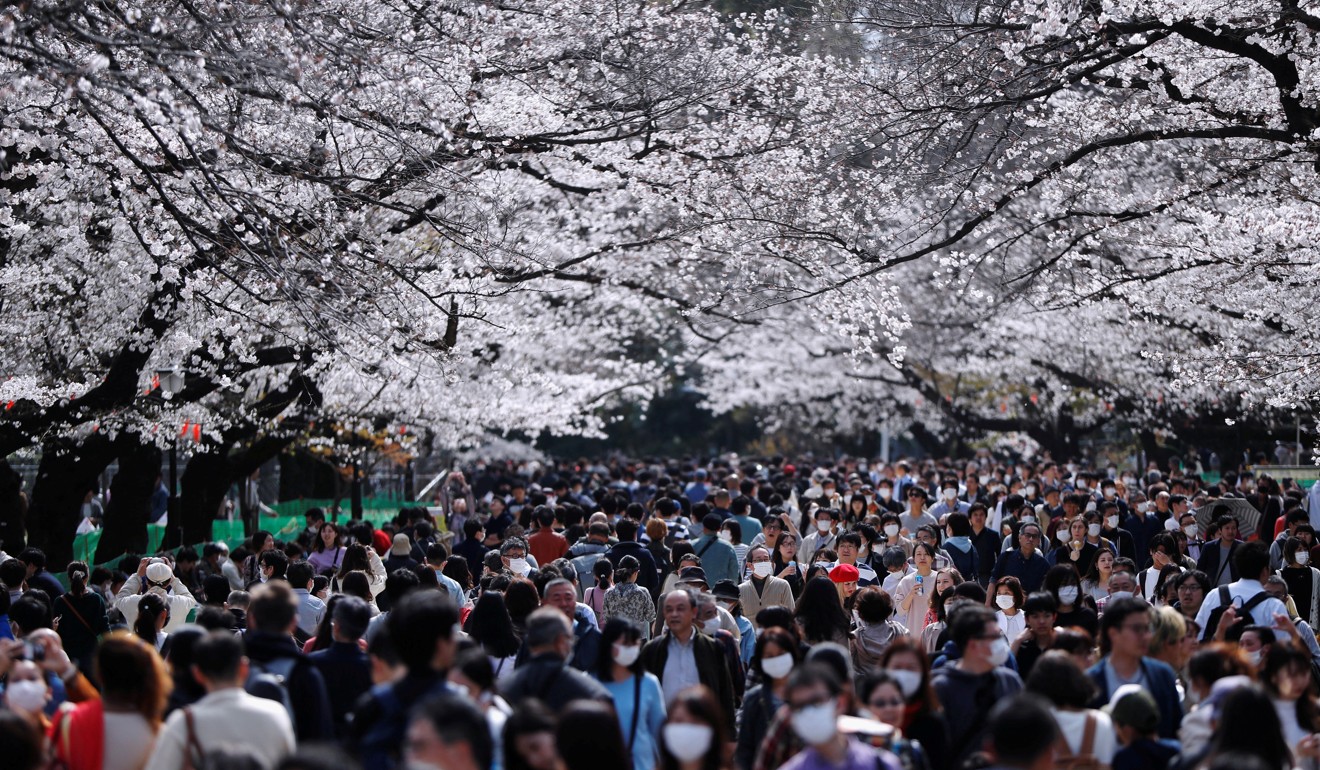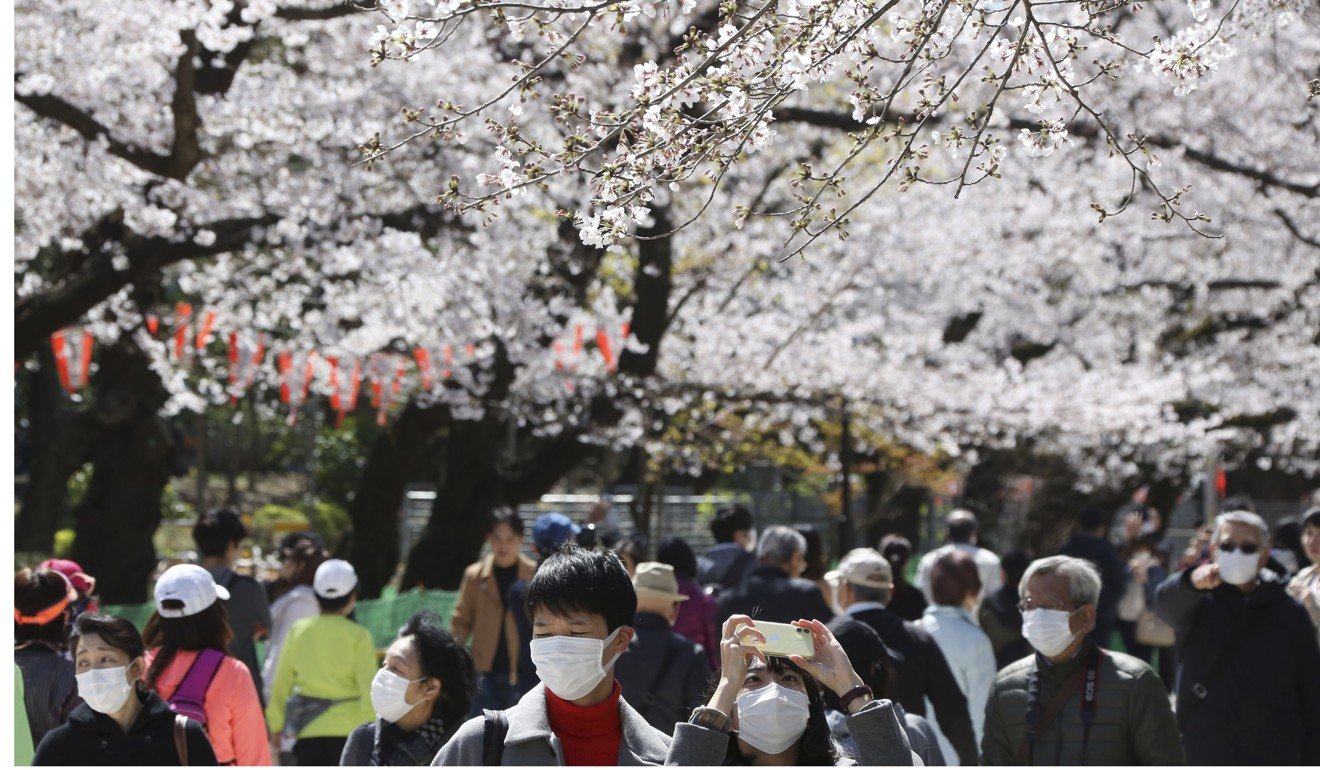
Coronavirus: Tokyo’s cherry blossoms bring thousands to parks but experts worry the worst isn’t over yet for Japan
- Japanese people bow instead of shaking hands and avoid direct contact with each other, so many believe they are relatively safe from Covid-19
- But health experts say Japan faces a serious risk and people are not taking the threat seriously enough
“I’m trying to stay away from them when I see them on the train because I know that I could be infected but that it would be far more serious for them,” she said.

Her sense of security is partly because of her location – the capital Tokyo has 14 million residents and has reported 171 cases as of Wednesday morning, about 14 per cent of the national total. Japan has had 1,214 infections and 43 deaths out of its population of 127 million people, and close to 900 patients have already been discharged from hospital. This figure excludes the Diamond Princess cruise ship that docked in Yokohama last month, where one in five people on board became infected.
In Italy, an estimated 0.1 per cent of the population of 60.5 million – or about 60,000 people – have been infected, with 5,476 deaths, while in Spain, about 0.06 per cent of the 46.66 million population – or 28,572 people – have been infected, with 1,720 people dying.
According to the Ministry of Health, Labour and Welfare, 12 people have been found to have the virus after arriving at airports and were subsequently quarantined.
Abe agrees to Tokyo 2020 postponement after call with Olympics chief
Experts say Japan’s comparatively low rate of infection may be due to low testing rates – the country carried out 18,322 tests before March 22, compared to almost 348,000 tests for South Korea’s 51 million population.
But Makoto Watanabe, an associate professor of communications at Hokkaido Bunkyo University, said ordinary Japanese people’s belief that they are relatively safe could also be attributed to social and cultural traditions.
People in Japan bow instead of shaking hands, hugging or kissing cheeks, he pointed out, while Japanese wash their hands frequently, shower or bathe daily and typically try to keep a distance between each other.
“It has always been like that in Japan, it’s part of our culture and I believe that perhaps people here act more out of respect for the broader community in which they live and work than elsewhere,” he said.
Thousands of Tokyo residents thronged parks over the past weekend to enjoy the early blooming of the cherry blossoms, while the K-1 kick-boxing organisation held matches before 6,500 fans at the Saitama Super Arena. Many people pack trains to get to work and are still dining out, with most shops and bars operating as usual.
On Monday, Tokyo Governor Yuriko Koike sought to dispel some of this complacency by warning that if more people fail to heed calls for “social distancing” she will have no option but to declare a lockdown in the city.
Japan’s cherry blossoms have come early but no one’s around to see them
Koike said the next three weeks are “critical” for whether the city will experience an explosive rise in infections. Part of the problem is that the greater Tokyo region encompasses six other surrounding prefectures and is home to more than 38.1 million people, many of whom travel into the city on a daily basis.
“Depending on developments, it is possible that we may need to take strong measures, such as a so-called lockdown of the city,” Koike said. “We must do our best to avoid that, so I want to ask all of the people of Tokyo for their further cooperation.”
I think citizens are not facing this epidemic with a sense of crisis and the impact of their actions on one another
Hitoshi Oshitani, a professor of virology at Tohoku University, said the riskiest environments are those that are enclosed, have low ventilation and draw large crowds, such as the K-1 kick-boxing, while cherry blossom viewing is less risky.
Hiroshi Nishiura, a professor of infectious disease epidemiology at Hokkaido University, warned that large-scale events risk a resurgence of the virus. “If behaviour returns to normal, there could be an explosion of cases like what’s happened in the United States and Europe,” Nishiura wrote in a commentary published on Yahoo Japan. “In particular, once major events have resumed in an endemic area, the outbreak can grow out of control.”
Japanese citizens “are not facing this epidemic with a sense of crisis and the impact of their actions on one another”, Nishiura said.
Coronavirus: Hokkaido ends state of emergency; Japan schools to reopen
While the first wave of infections originating from China was relatively small, Japan faces a more serious threat from explosive outbreaks in Europe and the United States. “We’re expecting that the second wave is much bigger,” Oshitani said.
At the current rate of transmission, experts predict there will be 530 cases in Tokyo by April 8 – although city officials appear to be less optimistic that numbers can be kept that low and have increased the number of hospital beds solely for coronavirus cases to 4,000.
World Bank data shows Japan has about 13 hospital beds per 1,000 people, the highest among the G7 nations and more than triple the rate for Italy and Britain.

Watanabe said he was not surprised that people were out enjoying the cherry blossoms as the government had only recommended they stay indoors.
“The recommendations so far are more of a soft ‘code of conduct’ rather than the strict and specific orders that are coming out in Europe,” he said.
“Japanese people are generally obedient and if it had been an official order then they would not have been out, but I also believe that anyone who does go out in these circumstances accepts the responsibility for their actions. They were aware of the risks and would blame no one for their actions.”
Coronavirus: how Japan’s response echoes 1918 Spanish flu guidelines
Kazuhiro Tateda, president of the Japan Association of Infectious Diseases and a member of the panel advising the government on the crisis, agreed that many of the everyday habits of Japanese people may be giving the population a degree of added protection, but he admitted to having some serious concerns.
“We feel at the moment that we are doing quite well with the infection numbers, although we still do not know much about what is going on under the surface,” he said.
“We do not know if supercarriers with no symptoms are walking around, visiting clubs and bars and pubs and spreading it. I worry that it is going to be the younger generation who are going to pass this virus on. For me, that is a very big concern.”
Additional reporting by Park Chan-kyong, Bloomberg, Kyodo and Reuters
Purchase the China AI Report 2020 brought to you by SCMP Research and enjoy a 20% discount (original price US$400). This 60-page all new intelligence report gives you first-hand insights and analysis into the latest industry developments and intelligence about China AI. Get exclusive access to our webinars for continuous learning, and interact with China AI executives in live Q&A. Offer valid until 31 March 2020.

